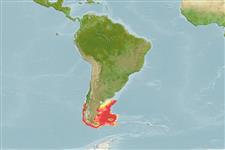Environment: milieu / climate zone / depth range / distribution range
Ecology
Marine; demersal; oceanodromous (Ref. 51243); depth range 30 - 1000 m. Subtropical; 40°S - 57°S, 76°W - 55°W (Ref. 1371)
Southeast Pacific and Southwest Atlantic: Patagonian region of Chile and Argentina, including the Falkland Islands and the Strait of Magellan.
Size / Weight / Age
Maturity: Lm ? range ? - ? cm
Max length : 50.0 cm TL male/unsexed; (Ref. 1371)
Dorsal spines (total): 0; Dorsal soft rays (total): 59 - 70; Anal spines: 0; Anal soft rays: 54 - 63; Vertebrae: 52 - 54. A small variably shaped patch of teeth on head of vomer. Pectoral fin extending beyond anal fin origin. Ventral light organ present. Color uniformly brown; fins dark-edged (Ref. 1371). Caudal fin rounded (Ref. 27363).
Body shape (shape guide): elongated; Cross section: oval.
Highest catches at 235 m. Females attain larger sizes than males. Larger individuals of both sexes move into deeper water. Utilized mainly for fishmeal; can be fried, microwaved and baked (Ref. 9988).
Life cycle and mating behavior
Maturity | Reproduction | Spawning | Eggs | Fecundity | Larvae
Cohen, D.M., T. Inada, T. Iwamoto and N. Scialabba, 1990. FAO species catalogue. Vol. 10. Gadiform fishes of the world (Order Gadiformes). An annotated and illustrated catalogue of cods, hakes, grenadiers and other gadiform fishes known to date. FAO Fish. Synop. 125(10). Rome: FAO. 442 p. (Ref. 1371)
IUCN Red List Status (Ref. 130435: Version 2025-1)
Threat to humans
Harmless
Human uses
Fisheries: minor commercial
Tools
Special reports
Download XML
Internet sources
Estimates based on models
Preferred temperature (Ref.
123201): 3.3 - 7.7, mean 5.7 °C (based on 115 cells).
Phylogenetic diversity index (Ref.
82804): PD
50 = 1.0000 [Uniqueness, from 0.5 = low to 2.0 = high].
Bayesian length-weight: a=0.00468 (0.00277 - 0.00790), b=3.11 (2.96 - 3.26), in cm total length, based on LWR estimates for this species & (Sub)family-body (Ref.
93245).
Trophic level (Ref.
69278): 4.4 ±0.3 se; based on diet studies.
Resilience (Ref.
120179): Medium, minimum population doubling time 1.4 - 4.4 years (Assuming tm=2-3).
Prior r = 0.57, 95% CL = 0.37 - 0.85, Based on 1 data-limited stock assessment.
Fishing Vulnerability (Ref.
59153): Moderate vulnerability (40 of 100).
🛈
Climate Vulnerability (Ref.
125649): Moderate to high vulnerability (54 of 100).
🛈
Nutrients (Ref.
124155): Calcium = 58 [29, 126] mg/100g; Iron = 0.945 [0.508, 1.791] mg/100g; Protein = 17.6 [15.2, 19.6] %; Omega3 = 0.26 [0.13, 0.50] g/100g; Selenium = 44.8 [20.4, 95.5] μg/100g; VitaminA = 23.2 [6.5, 84.7] μg/100g; Zinc = 0.592 [0.395, 0.902] mg/100g (wet weight); based on
nutrient studies.
